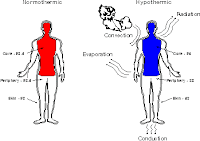First listen to the presentation:
Protection
1. In addition to injury and poisoning what else do we require protection from?
ANSWER: oxygen; heat; dehydration; infection.
2. Where are the symptoms of oxygen toxicity manifested?
ANSWER: eyes; lungs; brain; muscles.
3. In a reflex arc what is the correct order for: spinal cord; motor neurone; muscle; sensory neurone?
ANSWER: sensory neurone; spinal cord; motor neurone; muscle.
4. Name four things that can stimulate vomiting centre.
ANSWER: higher brain centres; chemicals; labyrinths; stomach.
5. What four things does the skin protect against?
ANSWER: physical damage; infection; dehydration; extremes of heat.
6. How is heat lost from the body?
ANSWER: radiation; convection; conduction; evaporation.
7. Name the three stages of wound healing and in the correct order?
ANSWER: inflammation; proliferation; maturation.
8. Briefly describe blood clotting.
ANSWER:
Prothrombin activator formed by intrinsic and extrinsic systems, converts
prothrombin to thrombin which converts
fibrinogen to fibrin which forms a
clot with platelets.
9. What are the cardinal signs of inflammation?
ANSWER: redness; heat; pain; swelling.
10. Name the components of non-specific and specific defence systems.
ANSWER: skin & macrophages (non-specific); cell mediated immunity & antigen mediated immunity (specific).
11. Describe active and passive immunity.
ANSWER: Active - natural (having a subclinical disease or infection), artificial (vaccine & toxoids); Passive - natural (from mother), artificial (antibodies).
















